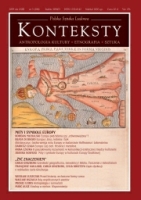Europa i Zeus, kobieta i byk. Ahistoryczna i laicka wersja mitu Europy w malarstwie Hoffmana i Lebensteina
Europa and Zeus, Woman and Bull. The Ahistorical and Laic Version of the Myth of Europe in Paintings by Hoffman and Lebenstein
Author(s): Beata Di BiasioSubject(s): Anthropology
Published by: Instytut Sztuki Polskiej Akademii Nauk
Keywords: anthropology; Europe; symbol; myth; painting
Summary/Abstract: „The Polish government commissioned from Franciszek Starowieyski, the renowned Polish painter, a composition to embellish the new building of the Permanent Representation of the Republic of Poland at the European Union in Brussels. The monumental Divina Polonia rapta per Europa profana, executed in 1998, was put on permanent show in the main hall of the Permanent Representation seat. ‘Divina Polonia’, the second female figure featured in the canvas next to Europe, is depicted with a halo. F. Starowieyski referred to the classical myth of Europe (a Phoenician princess abducted by Zeus disguised as a bull) in order to emphasize the contrast between secular Europe and ‘holy’ Poland. What is the source of this combination of nudity and saintliness? Why has this otherwise liberated artist, who in hundreds of compositions obsessively portrays the female nude and remains distant from bigotry or clericalism, suddenly resorted to religious symbols. These intriguing and disturbing questions arose after seeing an exhibition on the myth of Europe shown in Florence. There, works of twentieth-century artists from Western Europe did not contain religious symbols. We seem to be approaching the topical problem of the unity of Europe. The canvas Divina Polonia rapta per Europa profana is a symbolic summary of the two different historical experiences of the East and West of Europe. In Eastern Europe it was precisely culture and religion which proved to be the strongest fortress in the battle waged by the smaller nations of this part of the Continent against the imperialism of their more powerful neighbors. This issue, reflected in myth and expressed in Polish twentieth-century painting, remains an unresolved topic of fascinating interdisciplinary studies (history of art and political anthropology), whose results I shall attempt to present in my dissertation… Polish twentieth-century painting expresses two embodiments of the myth of Europe. On the one hand, the 'western' version, similarly to western art in general, recounts the story of twentieth-century European civilization, describes women’s liberation, and comments on the interminable relations between man and woman (Skoczylas, Nacht-Samborski, Manastyrski, Linke, Hoffmann, Lebenstein, Nowosielski). The same myth is also present in a ‘Polonised’ version (Starowieyski, Hasior, Grzywacz, Dwurnik), and undergoes a transformation into the ‘antemurale’ myth, which has shaped Polish historical identity for centuries…”
Journal: Konteksty
- Issue Year: 2009
- Issue No: 03
- Page Range: 45-53
- Page Count: 9
- Language: Polish
- Content File-PDF

